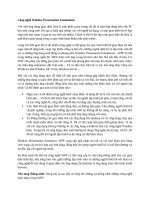12_Processor_Structure_and_Function doc
Bạn đang xem bản rút gọn của tài liệu. Xem và tải ngay bản đầy đủ của tài liệu tại đây (559.07 KB, 58 trang )
William Stallings
Computer Organization
and Architecture
7
th
Edition
Chapter 12
CPU Structure and Function
CPU Structure
•
CPU must:
—
Fetch instructions
—
Interpret instructions
—
Fetch data
—
Process data
—
Write data
CPU With Systems Bus
CPU Internal Structure
Registers
•
CPU must have some working space (temporary
storage)
•
Called registers
•
Number and function vary between processor
designs
•
One of the major design decisions
•
Top level of memory hierarchy
User Visible Registers
•
General Purpose
•
Data
•
Address
•
Condition Codes
General Purpose Registers (1)
•
May be true general purpose
•
May be restricted
•
May be used for data or addressing
•
Data
—
Accumulator
•
Addressing
—
Segment
General Purpose Registers (2)
•
Make them general purpose
—
Increase flexibility and programmer options
—
Increase instruction size & complexity
•
Make them specialized
—
Smaller (faster) instructions
—
Less flexibility
How Many GP Registers?
•
Between 8 - 32
•
Fewer = more memory references
•
More does not reduce memory references and
takes up processor real estate
•
See also RISC
How big?
•
Large enough to hold full address
•
Large enough to hold full word
•
Often possible to combine two data registers
—
C programming
—
double int a;
—
long int a;
Condition Code Registers
•
Sets of individual bits
—
e.g. result of last operation was zero
•
Can be read (implicitly) by programs
—
e.g. Jump if zero
•
Can not (usually) be set by programs
Control & Status Registers
•
Program Counter
•
Instruction Decoding Register
•
Memory Address Register
•
Memory Buffer Register
•
Revision: what do these all do?
Program Status Word
•
A set of bits
•
Includes Condition Codes
•
Sign of last result
•
Zero
•
Carry
•
Equal
•
Overflow
•
Interrupt enable/disable
•
Supervisor
Supervisor Mode
•
Intel ring zero
•
Kernel mode
•
Allows privileged instructions to execute
•
Used by operating system
•
Not available to user programs
Other Registers
•
May have registers pointing to:
—
Process control blocks (see O/S)
—
Interrupt Vectors (see O/S)
•
N.B. CPU design and operating system design
are closely linked
Example Register Organizations
Instruction Cycle
•
Revision
•
Stallings Chapter 3
Indirect Cycle
•
May require memory access to fetch operands
•
Indirect addressing requires more memory
accesses
•
Can be thought of as additional instruction
subcycle
Instruction Cycle with Indirect
Instruction Cycle State Diagram
Data Flow (Instruction Fetch)
•
Depends on CPU design
•
In general:
•
Fetch
—
PC contains address of next instruction
—
Address moved to MAR
—
Address placed on address bus
—
Control unit requests memory read
—
Result placed on data bus, copied to MBR, then to IR
—
Meanwhile PC incremented by 1
Data Flow (Data Fetch)
•
IR is examined
•
If indirect addressing, indirect cycle is performed
—
Right most N bits of MBR transferred to MAR
—
Control unit requests memory read
—
Result (address of operand) moved to MBR
Data Flow (Fetch Diagram)
Data Flow (Indirect Diagram)
Data Flow (Execute)
•
May take many forms
•
Depends on instruction being executed
•
May include
—
Memory read/write
—
Input/Output
—
Register transfers
—
ALU operations









